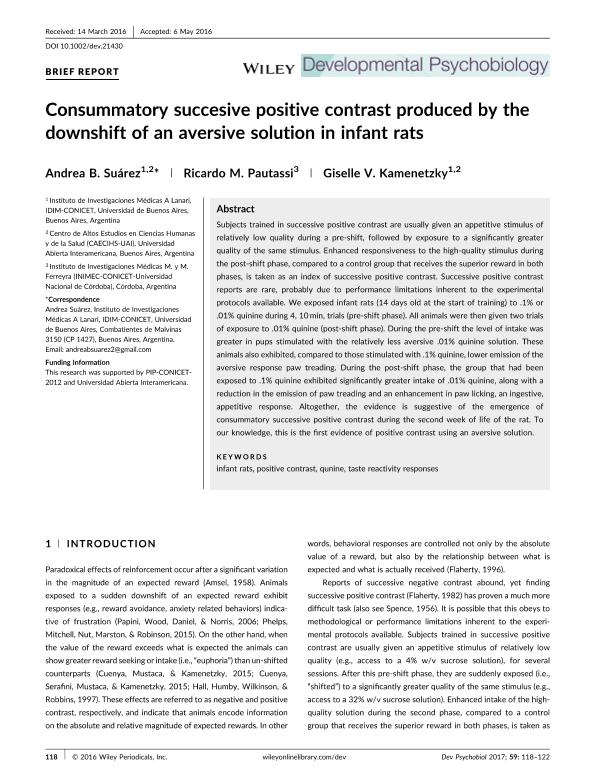Mostrar el registro sencillo del ítem
dc.contributor.author
Suarez, Andrea Beatriz

dc.contributor.author
Pautassi, Ricardo Marcos

dc.contributor.author
Kamenetzky, Giselle Vanesa

dc.date.available
2018-06-04T17:42:56Z
dc.date.issued
2017-01
dc.identifier.citation
Suarez, Andrea Beatriz; Pautassi, Ricardo Marcos; Kamenetzky, Giselle Vanesa; Consummatory succesive positive contrast produced by the downshift of an aversive solution in infant rats; John Wiley & Sons Inc; Developmental Psychobiology; 59; 1; 1-2017; 118-122
dc.identifier.issn
0012-1630
dc.identifier.uri
http://hdl.handle.net/11336/47162
dc.description.abstract
Subjects trained in successive positive contrast are usually given an appetitive stimulus of relatively low quality during a pre‐shift, followed by exposure to a significantly greater quality of the same stimulus. Enhanced responsiveness to the high‐quality stimulus during the post‐shift phase, compared to a control group that receives the superior reward in both phases, is taken as an index of successive positive contrast. Successive positive contrast reports are rare, probably due to performance limitations inherent to the experimental protocols available. We exposed infant rats (14 days old at the start of training) to .1% or .01% quinine during 4, 10 min, trials (pre‐shift phase). All animals were then given two trials of exposure to .01% quinine (post‐shift phase). During the pre‐shift the level of intake was greater in pups stimulated with the relatively less aversive .01% quinine solution. These animals also exhibited, compared to those stimulated with .1% quinine, lower emission of the aversive response paw treading. During the post‐shift phase, the group that had been exposed to .1% quinine exhibited significantly greater intake of .01% quinine, along with a reduction in the emission of paw treading and an enhancement in paw licking, an ingestive, appetitive response. Altogether, the evidence is suggestive of the emergence of consummatory successive positive contrast during the second week of life of the rat. To our knowledge, this is the first evidence of positive contrast using an aversive solution.
dc.format
application/pdf
dc.language.iso
eng
dc.publisher
John Wiley & Sons Inc

dc.rights
info:eu-repo/semantics/openAccess
dc.rights.uri
https://creativecommons.org/licenses/by-nc-sa/2.5/ar/
dc.subject
Positive_Contrast
dc.subject
Quinine
dc.subject
Taste_Reactivity_Responses
dc.subject
Infant_Rats
dc.subject.classification
Psicología

dc.subject.classification
Psicología

dc.subject.classification
CIENCIAS SOCIALES

dc.title
Consummatory succesive positive contrast produced by the downshift of an aversive solution in infant rats
dc.type
info:eu-repo/semantics/article
dc.type
info:ar-repo/semantics/artículo
dc.type
info:eu-repo/semantics/publishedVersion
dc.date.updated
2018-06-04T17:04:48Z
dc.journal.volume
59
dc.journal.number
1
dc.journal.pagination
118-122
dc.journal.pais
Estados Unidos

dc.journal.ciudad
Nueva York
dc.description.fil
Fil: Suarez, Andrea Beatriz. Consejo Nacional de Investigaciones Científicas y Técnicas; Argentina. Universidad de Buenos Aires. Facultad de Medicina. Instituto de Investigaciones Médicas; Argentina. Universidad Abierta Interamericana; Argentina
dc.description.fil
Fil: Pautassi, Ricardo Marcos. Consejo Nacional de Investigaciones Científicas y Técnicas. Centro Científico Tecnológico Conicet - Córdoba. Instituto de Investigación Médica Mercedes y Martín Ferreyra. Universidad Nacional de Córdoba. Instituto de Investigación Médica Mercedes y Martín Ferreyra; Argentina
dc.description.fil
Fil: Kamenetzky, Giselle Vanesa. Universidad de Buenos Aires. Facultad de Medicina. Instituto de Investigaciones Médicas; Argentina. Universidad Abierta Interamericana; Argentina
dc.journal.title
Developmental Psychobiology

dc.relation.alternativeid
info:eu-repo/semantics/altIdentifier/doi/https://dx.doi.org/10.1002/dev.21430
dc.relation.alternativeid
info:eu-repo/semantics/altIdentifier/url/https://onlinelibrary.wiley.com/doi/abs/10.1002/dev.21430
Archivos asociados
